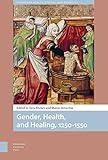Gender, Health, and Healing, 1250-1550 / ed. by Sara Ritchey, Sharon Strocchia.
Material type: TextSeries: Premodern Health, Disease, and Disability ; 3Publisher: Amsterdam : Amsterdam University Press, [2020]Copyright date: ©2020Description: 1 online resource (330 p.)Content type:
TextSeries: Premodern Health, Disease, and Disability ; 3Publisher: Amsterdam : Amsterdam University Press, [2020]Copyright date: ©2020Description: 1 online resource (330 p.)Content type: - 9789048544462
- Medical care -- History -- To 1500 -- Europe
- Medical care -- Europe -- History -- To 1500
- Medicine, Medieval
- Women in medicine -- History -- To 1500
- Early Modern Studies
- Gender and Sexuality Studies
- Health and Medicine
- High Middle Ages
- History, Art History, and Archaeology
- Sociology and Social History
- HISTORY / Medieval
- Disability
- Gender
- Health
- Medicine
- Religion
- 610.902 23
- online - DeGruyter
| Item type | Current library | Call number | URL | Status | Notes | Barcode | |
|---|---|---|---|---|---|---|---|
 eBook
eBook
|
Biblioteca "Angelicum" Pont. Univ. S.Tommaso d'Aquino Nuvola online | online - DeGruyter (Browse shelf(Opens below)) | Online access | Not for loan (Accesso limitato) | Accesso per gli utenti autorizzati / Access for authorized users | (dgr)9789048544462 |
Frontmatter -- Table of Contents -- List of Figures and Tables -- Acknowledgments -- Abbreviations -- Introduction -- Part 1. Sources of Religious Healing -- 1 Caring by the Hours. The Psalter as a Gendered Healthcare Technology -- 2 Female Saints as Agents of Female Healing. Gendered Practices and Patronage in the Cult of St. Cunigunde -- Part 2. Producing and Transmitting Medical Knowledge -- 3 Blood, Milk, and Breastbleeding. The Humoral Economy of Women’s Bodies in Medieval Medicine -- 4 Care of the Breast in the Late Middle Ages. The Tractatus de passionibus mamillarum -- 5 Household Medicine for a Renaissance Court. Caterina Sforza’s Ricettario Reconsidered -- 6. Understanding/Controlling the Female Body in Ten Recipes. Print and the Dissemination of Medical Knowledge about Women in the Early Sixteenth Century -- Part 3. Infirmity and Care -- 7 Ubi non est mulier, ingemiscit egens? Gendered Perceptions of Care from the Thirteenth to Sixteenth Centuries -- 8 Domestic Care in the Sixteenth Century. Expectations, Experiences, and Practices from a Gendered Perspective -- 9 Bathtubs as a Healing Approach in Fifteenth-Century Ottoman Medicine -- Part 4. (In)fertility and Reproduction -- 10 Gender, Old Age, and the Infertile Body in Medieval Medicine -- 11 Gender Segregation and the Possibility of Arabo-Galenic Gynecological Practice in the Medieval Islamic World -- Afterword. Healing Women and Women Healers -- Contributors -- Index
restricted access online access with authorization star
http://purl.org/coar/access_right/c_16ec
This path-breaking collection offers an integrative model for understanding health and healing in Europe and the Mediterranean from 1250-1550. By foregrounding gender as an organizing principle of healthcare, the contributors challenge traditional binaries that ahistorically separate care from cure, medicine from religion, and domestic healing from fee-for-service medical exchanges. The essays collected here illuminate previously hidden and undervalued forms of healthcare and varieties of body knowledge produced and transmitted outside the traditional settings of university, guild, and academy. They draw on non-traditional sources-vernacular regimens, oral communications, religious and legal sources, images and objects-to reveal additional locations for producing body knowledge in households, religious communities, hospices, and public markets. Emphasizing cross-confessional and multi-linguistic exchange, the essays also reveal the multiple pathways for knowledge transfer in these centuries. The volume provides a synoptic view of how gender and cross-cultural exchange shaped medical theory and practice in later medieval and Renaissance societies.
Mode of access: Internet via World Wide Web.
In English.
Description based on online resource; title from PDF title page (publisher's Web site, viewed 27. Jan 2023)


